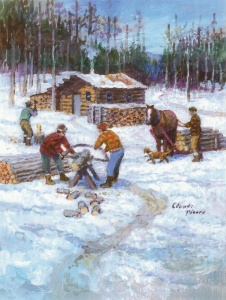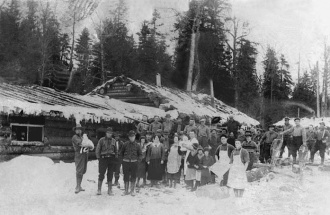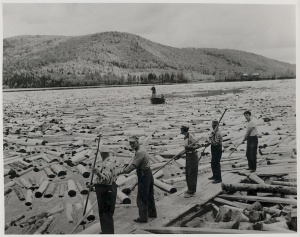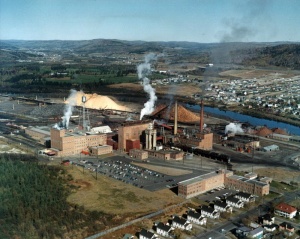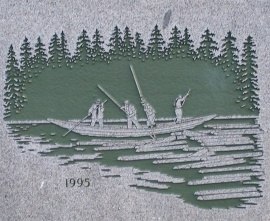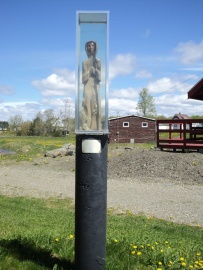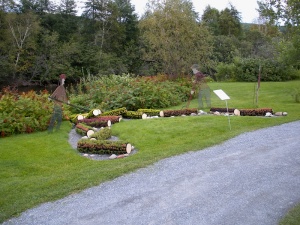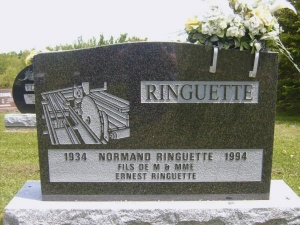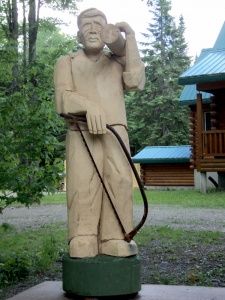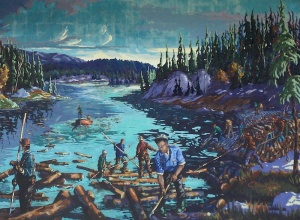The Acadians’ Madawaska: a Land of Farms and Forests
par Lang, Nicole
Forestry has played a key role in Madawaska’s economic, social and cultural development since the first half of the 19th century. Over the years, the forest has become an important symbol of the identity of this region in New Brunswick. Throughout the area, everything celebrates the successes and failures of the forestry workers: monuments, plaques, public art installations, as well as architectural sites and events. Nobody is forgotten: log drivers, loggers, logging equipment operators, tree planters, sawmill workers, cooks, and others. Many aspects of Madawaska’s cultural heritage reflect the impact of this vital sector in the economy.
Article disponible en français : Madawaska : l'Acadie des terres et forêts
The Development of the Forest Industry in the Madawaska Region
Situated in North-eastern New Brunswick, Madawaska is home mainly to the Maliseet First Nation. The colonisation of the area really started in 1785 when the Acadian and Canadian Colonists arrived. These first French-speaking inhabitants made their living through agriculture. Little by little, those who lived on smaller lots or on land that wasn’t very fertile looked to the forest to make ends meet (NOTE 1). This started an economic trend that would come to characterise the area and leave a lasting mark on its history.
The Forestry industry developed rapidly in the region throughout the 19th century. The first logging sites sprung up around 1820. At the time, Madawaska’s forests were harvested to meet the growing demands of naval construction, first in Great Britain and then in Saint-John, in Southern New Brunswick. White pine, found in abundance in the Saint-John River Valley, was highly prized and useful for making masts for ships. Entrepreneurs from outside the region controlled operations along both sides of the river. These businessmen came from the United States, Southern New Brunswick and from Lower Canada. The local inhabitants weren’t in control of the development of this sector because they didn’t have the necessary capital. They were hired as loggers or log drivers. The larger-scale farmers, however, benefited economically from the opening of the logging sites since they supplied the logging camps with their agricultural products (NOTE 2).
The industry was affected by the border dispute between Maine and New Brunswick which was taking place at the same time. Cutting and transportation were disrupted for several years. The Ashburton-Webster Treaty (also known as the Treaty of Washington) ended the conflict in 1842 and the Saint John River became the international border in the Madawaska area. A clause in the treaty allowed for free right of passage for both American and British products both on the river and its tributaries which allowed forestry operators to maintain their rights to float timber downstream (NOTE 3).
After 1850, the political situation was more stable. Logging camps were springing up around the area and sawmills were being constructed. The demand for sawn timber grew and grew. More and more local jobs were created thanks to the opening of bigger sawmills like Bob Connors’ Mill in Upper Madawaska in 1875, James Murchie & Sons’ Sawmill in Edmundston in 1884 and the Fraser Family’s Mill in Baker Brook in 1904 (NOTE 4).
At the beginning of the 20th century, there was a transition from the sawn timber industry to that of pulp and paper. In fact, the construction of a mechanical pulp mill by Fraser Companies Limited in Edmundston (1917) was the start of a new era for the forestry industry. Hundreds of jobs were created. Over the following years, the company continued to grow. In addition to acquiring new lands, it invested large sums in its Edmundston operations. A chemical pulp mill and a cardboard producing factory were constructed. In its heyday, they hired almost 1000 workers in the Edmundston area and became one of the economic pillars of the region (NOTE 5).
The second half of the 20th century brought big changes to the Madawaska region as it did elsewhere in North America. The mechanisation of the work and the automation of the mills would bring with it job cuts and important changes to how work was organised (NOTE 6). A major economic crisis in the forestry industry at the beginning of the 21st century eventually lead to the permanent or temporary closure of several mills and logging sites. Hundreds of jobs were lost. In spite of all the changes and upheaval, the industry remained a major economic player in the Madawaska region.
The Forest, the Very Foundation of the Madawaska Region’s Cultural Heritage
In many Madawaskan municipalities (such as Saint-Léonard and Saint-Jacques), public art, monuments, plaques, architectural sites and even tombstones stand as symbolic reminders, to local people and visitors alike of the historic importance and major role the forest industry played in region’s history and culture.
Log driving was done by many men in Saint-Léonard and surrounding communities. They floated logs and wood for paper on the Saint John River and its tributaries. The town of Saint-Léonard and the forestry company Irving wanted to recognize the importance of log driving in the community’s history and also to give homage to all the workers who did a very dangerous job. Irving therefore set up a monument in the downtown park in 1995. It was unveiled in July of that year during the 75th anniversary of the municipality’s incorporation (NOTE 7).
The following year, the community launched its first Festival du draveur acadien (NOTE 8), which included log driving competitions. It was an occasion that gave the people in the community a chance to reconnect with local history. In 2004, close to the municipal tourist centre, painter Clarence Bourgoin was commissioned to do a great fresco (NOTE 9). Entitled Une rivière de souvenirs, this fresco depicts log drivers working on the Saint John River in the 1950s.
They also commissioned small statue by Eugène Jankowski, which is set up only a short distance from the fresco. The log driver’s prayer is inscribed on a plaque attached to the sculpture (NOTE 10). Another memorial to the region’s history is the local hockey team which proudly calls itself Les Draveurs du Bas-Madawaska.
Right next to the Quebec border is the community of Saint-Jacques. Today it is considered to be a part of the City of Edmundston. This small community is also a historical reminder of the importance of the forest industry in the region’s history. In fact, many members of the community have worked either in one of the village’s sawmills, in the region’s logging camps or in the Fraser sawmill in Edmundston, while some have even worked as log drivers. The parish’s coat of arms also testifies to the important role that the forest has played in the people’s lives. On the upper half of the shield is emblazoned with two crossed logs (NOTE 11) as a reminder of the local forests that were an abundant source of wealth and of the log drive of years gone by. The convergence of the Madawaska River and the Rivière-à-la-Truite, two key waterways for the forestry industry (NOTE 12), are also depicted on the coat of arms.
In the heart of the Saint-Jacques community is the Jardin Botanique du Nouveau Brunswick, which includes a topiary piece which depicts log driver and logs floating through a garden mosaic. This piece of public art combines drawings with framed shrubbery and plants. Local artist Albert Deveau created metal frames depicting log drivers and logs. The garden’s employees planted flowers around it. It is possible to visit the mosaic which blooms every summer in the section of the garden next to the Madawaska River. The log drive continued on this river as late as the end of the 19th century to the middle of the 20th century. There is an interpretative text with this piece of garden artwork, which is intended to help visitors to better understand the particulars of log driving, as well as the dangers associated with it.
On August 21st 2008, the province of New Brunswick designated the Fraser Company’s sluice as a local cultural heritage site(NOTE 13). This sluice was used to unload softwood lumber (called “pitounes” at the time) to bring it to sawmills in the region, as well as to the Fraser pulp mill in downtown Edmundston (NOTE 14). Today, the site is made up of remains of cement blocks set up on the shoreline along the Madawaska River. The remains of the sluice are one of the few signs left of the river’s log driving era, which flourished between 1820 and 1950.
The Forest, a Place of Collective Memory; Forestry Implements Inscribed on Tombstones
Working in the forestry industry involves inherent risks. Madawaska has seen its share of tragedies in its various logging sites, factories and on the river since the early 19th century. Several points of interest commemorate these tragedies. For example, one such monument was erected in the forest for Raymond J. LeBlanc, a forestry worker originally from Dalhousie. LeBlanc worked northwest of Kedgwick, near the Quebec border. He was killed blasting out a logging road in the forest while working for Fraser Companies Limited In November 1949. The death was declared accidental. Shortly after the tragedy, a cross and a plaque were set up by his family and friends near where he died. The LeBlanc Gulch, a local ravine is also named after him (NOTE 15).
Another such example of a log driver memorial erected in homage to a worker who died in the forest is the monument dedicated to Éric Volpé. This young forestry worker lost his life in March 2004 when he got stuck under a felled tree. The accident happened near Camp 68, near Otter Brook Way, about 70 kilometres away from Edmundston. The Volpé family, along with Irving, put up a commemorative monument in the forest, near the accident site. The unveiling took place as a part of a private ceremony (NOTE 16).
There are also occupation symbols inscribed on tombstones in Acadian cemeteries in communities all across New Brunswick. On the Acadian Peninsula, symbols depicting fishing are inscribed in the epitaph, while in the Madawaska region, it is rather images that depict forestry work, such as a truck hauling logs, a mechanical saw, or even a logger cutting down a tree. These images illustrate just how important a role fishing and forestry work played in the region and how it was an integral part of the cultural the identity of these people.
Madawaskan Artists and the Forest, an Artistic Love Affair
Many Madawaskan artists have created works of art that show a strong connection with the forest: artists such as Clarence Bourgoin and the painter Claude Picard, who painted several canvases illustrating scenes of living and working in the forests and on the rivers of Madawaska. Another artist, Albert Deveau used a mechanical saw to create works of art out of logs of white pine and elm. He crafted these sculptures to honour people, as well as to showcase the significance of an industry or an event. Throughout the last few years, Deveau produced several sculptures of forestry workers, such as Armand Boulet, scaler and Christmas tree producer from Connors (in Upper Madawaska), or George Francoeur, who cleared and worked logging sites in the Edmundston region. All these works give voice to the importance of the forest in Madawaskan history and culture.
The Region’s Forest Heritage, a Significant Part of the Community’s Cultural Heritage
The forest is at the heart of the cultural heritage in Madawaska. In numerous memorial sites, public art, sites and architectural remains tell the story not only of the economic development of the region but also the history and collective memory of a people’s very existence. The forest has profoundly marked the history and culture of this Acadian region, which many people today call the farming and forestlands of Acadia.
Nicole Lang
Université de Moncton, Edmundston campus
Additional DocumentsSome documents require an additional plugin to be consulted
Images
-
 Armand Boulet : mesur
Armand Boulet : mesur
eur de bois et ... -
 Bûcherons au lac de l
Bûcherons au lac de l
’Est (près du l... -
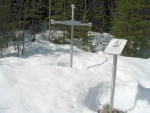 Croix et plaque en mé
Croix et plaque en mé
moire de Raymon... -
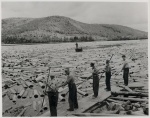 Draveurs sur la riviè
Draveurs sur la riviè
re Saint-Jean e...
-
 George Francoeur : dé
George Francoeur : dé
fricheur et tra... -
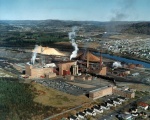 L’usine Fraser d’Edmu
L’usine Fraser d’Edmu
ndston en 1965... -
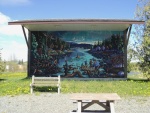 La fresque « Une rivi
La fresque « Une rivi
ère de souvenir... -
 La fresque « Une rivi
La fresque « Une rivi
ère de souvenir...
-
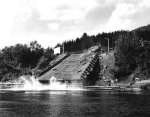 La glissoire de la co
La glissoire de la co
mpagnie Fraser -
 Le forgeron Michaud -
Le forgeron Michaud -
Saint-François... -
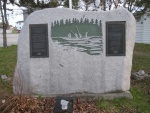 Le monument des drave
Le monument des drave
urs, Saint-Léon... -
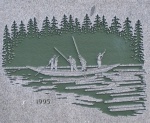 Le monument des drave
Le monument des drave
urs, Saint-Léon...
-
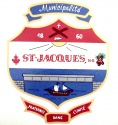 Les armoiries de la p
Les armoiries de la p
aroisse de Sain... -
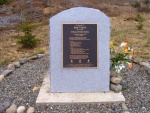 Monument dédié à Éric
Monument dédié à Éric
Volpé -
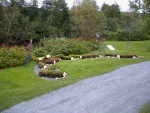 Mosaïculture : la dra
Mosaïculture : la dra
ve au Madawaska... -
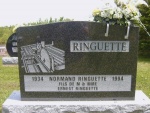 Pierre tombale (Ringu
Pierre tombale (Ringu
ette), Sainte-A...
-
 Sculpture et prière d
Sculpture et prière d
u draveur, Sain... -
 Travail des bûcherons
Travail des bûcherons
-
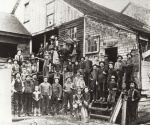 Travailleurs de la sc
Travailleurs de la sc
ierie Murchie à... -
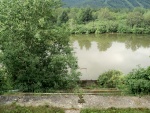 Un lieu patrimonial l
Un lieu patrimonial l
ocal : la gliss...
Hyperliens
- Unravelling the Fresco. An interactive multi-media painting of life in the lands and forests of Acadia.
- Labour History in New Brunswick
- New Brunswick's Historic Places
- Knock on Wood: The forest at the heart of the madawaskayan social and cultural heritage in Acadie
Catégories
Notes
1. Georgette Desjardins (dir.), « L'établissement des Acadiens au Madawaska » et « La population de Saint-Basile, 1792-1989 », Saint-Basile, berceau du Madawaska, 1792-1992, Montréal, Méridien, 1992, p. 31-39, 131-144.
2. Ibid., p. 325-339. Voir également Béatrice Craig et Maxime Dagenais, The Land in Between : The Upper St. John Valley, Prehistory to World War I, Gardiner (Me), Tilbury House Publishers; Madawaska (Me), Maine Acadian Heritage Council; Bar Harbor (Me), Acadia National Park et Saint Croix Island International Historic Site, 2009, p. 178-200; et Richard W. Judd, Aroostook : A Century of Logging in Northern Maine, Orono (Me), University of Maine Press, 1989, 351 p.
3. Voir Nicole Lang, « Le conflit de la frontière internationale au Madawaska », Les Cahiers du GERHICO, no 2, 2001, p. 133-144; et Francis Thériault, « La signature du traité Ashburton-Webster », Revue de la Société historique du Madawaska, vol. XXXIII, nos 1-2, janvier-juin 2005, p. 4-34.
4. Voir le site Toucher du bois : la forêt au cœur du patrimoine social et culturel madawaskayen en Acadie [en ligne], http://www.toucherdubois.ca.
5. Nicole Lang, « De l'entreprise familiale à la compagnie moderne : la Fraser Companies Limited de 1918 à 1974 », Acadiensis, vol. XXV, no 2, printemps 1996, p. 42-61;id., « L'impact d'une industrie : les effets sociaux de l'arrivée de la Compagnie Fraser Limited à Edmundston, N.-B., 1900-1950 », Revue de la Société historique du Madawaska, vol. XV, nos 1-2, janvier-juin 1987, p. 2-71.
6. LHTNB.ca (Labour History in New Brunswick / Histoire du travail au Nouveau-Brunswick), « Un territoire contesté : la transformation des forêts », Modules pédagogiques[en ligne], http://www.lhtnb.ca/pedagogie/territoire.cfm.
7. Le monument rend d'abord hommage aux draveurs. Il souligne aussi le travail des hommes en forêt, c'est-à-dire les bûcherons, les cuisiniers, les commis, les conducteurs d'équipements forestiers, les mécaniciens, les planteurs d'arbres et les travailleurs des scieries. Voir Sylvie Paulin, « 75 ans d'histoire se sont célébrées en grand », La Cataracte, 19 juillet 1995, p. 6; et Marie-Josée Plourde, « À Ville Saint-Léonard : participation massive aux célébrations du 75e anniversaire », Le Madawaska, 19 juillet 1995, p. 1-A, 2-A.
8. Le festival voulait rendre hommage aux ancêtres acadiens qui pratiquèrent la drave. Il exista de 1996 à 2002. Durant les deux premières années, il fut organisé par la Fédération des jeunes francophones du Nouveau-Brunswick, section Madawaska-Victoria, en collaboration avec la municipalité de Saint-Léonard. La Ville prit ensuite la relève et organisa le festival avec l'aide de jeunes de la communauté. Chaque été, le festival présentait donc une variété d'activités à la mi-août, soit des spectacles, des jeux et compétitions, des expositions, un pique-nique familial, etc. Chaque année, la drave occupait une place de choix dans la programmation. Voir, entre autres, Marie-Josée Plourde, « Festival du draveur acadien », Le Madawaska, 3 juillet 1996, p. 5-A; « Du 14 au 17 août, Saint-Léonard en fête », Le Madawaska, 13 août 1997, p. 1-A, 2-A; et « Festival du draveur “traditionnel et actuel” », Le Madawaska, 20 août 1997, p. 16-A.
9. Cette fresque fut réalisée grâce à l'appui financier de la Ville de Saint-Léonard, de l'Agence de mise en marché des œuvres d'art (AMMOA) et de l'Association acadienne des artistes professionnels du Nouveau-Brunswick (AAAPNB). L'artiste réalisa un premier croquis et débuta la fresque en juillet 2004. Selon Bourgoin, plus de 400 heures de création auront été nécessaires à la réalisation de cette œuvre.
10. La prière se lit comme suit : « Prière pour le draveur : O mon Dieu tout puissant, protège mon homme qui est parti faire de la drave. Fais en sorte que l'eau frigide de la rivière soit calme et douce et le courant pas trop fort. Que le temps soit clément. Rends ses pieds agiles quand il court sur les billes de bois trempées, comme s'il était en train de danser la valse avec moi. Je t'en prie mon Dieu fais en sorte que mon homme me revienne, afin que je puisse le réchauffer en l'enlaçant dans mes bras. »
11. Albert Clavette, Municipalité de St-Jacques, N.-B., de 1960 à l'an 2000, Cap-Saint-Ignace (Qc), Plume d'oie, 2000, 255 p.
12. Guy R. Michaud, La paroisse de Saint-Jacques, Nouveau-Brunswick, Edmundston, Éditions GRM, 1988, p. 88.
13. Terme employé par les gens du Madawaska; il figure aussi dans le Répertoire des lieux patrimoniaux du Nouveau-Brunswick.
14. Nouveau-Brunswick, Ministère du Mieux-être, de la Culture et du Sport, « Glissoire “sluice” de Saint-Jacques », Répertoire des lieux patrimoniaux du Nouveau-Brunswick[en ligne], http://www.rhp-rlp.gnb.ca/Page1.aspx?blnLanguageEnglish=False&RID=1590&VER=1&dp=1.
15. LeBlanc était âgé de 42 ans et il était le père de six enfants. Voir « Raymond LeBlanc tué par une explosion », L'Évangéline, 1er décembre 1949, p. 8; « Raymond LeBlanc is Accident Victim », Dalhousie News, vol. XX, no 45, 1er décembre 1949, p. 1; « Tragedy Termed Accidental : Dynamite Explosion Claimed Life Father of Six Children », Campbellton Graphic, 1er décembre 1949, p. 1; et « Funeral of Raymond LeBlanc at Dalhousie », Campbellton Tribune, 7 décembre 1949, p. 5. Le ravin était connu sous le nom de Grays Gulch avant d'être renommé en mémoire de Raymond J. LeBlanc. Voir Alan Rayburn, Geographical Names of New Brunswick, Ottawa, Surveys and Mapping Branch, Department of Energy, Mines and Resources, 1975, p. 153.
16. Voir Paul Grondin, « Décès accidentel d'un travailleur forestier », Le Madawaska, 24 mars 2004, p. 1-A, 2-A; « Accident de travail mortel sur les terres de la compagnie Irving », L'Acadie nouvelle, 17 mars 2004, p. 2; « Madawaska Man Identified as Victim of Logging Accident », The Daily Gleaner, 18 mars 2004, p. A-3; et « Logger's Death Ruled Accidental », Telegraph Journal, 2 avril 2004, p. A-4.
Bibliographie
Couturier, Oneil, « L'histoire de l'ancienne “wood room” chez Fraser, 1917-1970 » (parties 1 et 2), Revue de la Société historique du Madawaska, vol. XXVIII, nos 1-2, janvier-juin 2000, p. 3-67; nos 3-4, juillet-décembre 2000, p. 2-67.
Craig, Béatrice, et Maxime Dagenais, The Land in Between : The Upper St. John Valley, Prehistory to World War I, Gardiner (Me), Tilbury House Publishers; Madawaska (Me), Maine Acadian Heritage Council; Bar Harbor (Me), Acadia National Park et Saint Croix Island International Historic Site, 2009, 442 p.
Desjardins, Georgette (dir.), Saint-Basile, berceau du Madawaska, 1792-1992, Montréal, Méridien, 1992, 452 p.
Frank, David, et Nicole Lang, Labour Landmarks in New Brunswick / Lieux historiques ouvriers au Nouveau-Brunswick, Edmonton, Comité canadien sur l'histoire du travail, 2010, 112 p.
Landry, Nicolas, et Nicole Lang, Histoire de l'Acadie, Sillery (Qc), Septentrion, 2001, 335 p.
Lang, Nicole, « L'impact d'une industrie : les effets sociaux de l'arrivée de la Compagnie Fraser Limited à Edmundston, N.-B., 1900-1950 », Revue de la Société historique du Madawaska, vol. XV, nos 1-2, janvier-juin 1987, p. 2-71.
Lang, Nicole, « De l'entreprise familiale à la compagnie moderne : la Fraser Companies Limited de 1918 à 1974 », Acadiensis, vol. XXV, no 2, printemps 1996, p. 42-61.
Lang, Nicole, « Les conséquences des changements administratifs et technologiques sur l'organisation du travail à l'usine Fraser d'Edmundston au Nouveau-Brunswick, 1947-1974 », Labour / Le Travail, vol. 43, printemps 1999, p. 121-146.
Lang, Nicole, « Le conflit de la frontière internationale au Madawaska », Les Cahiers du GERHICO, no 2, 2001, p. 133-144.
Lavoie Bélanger, Fernande, Ma vie, c'est la forêt, Moncton, Éditions de la Francophonie, 2005, 224 p.

